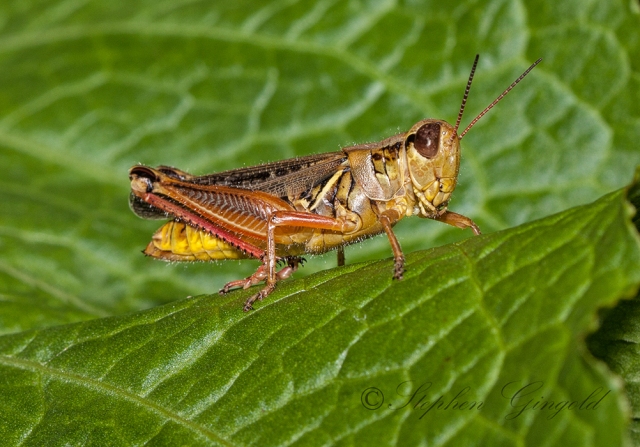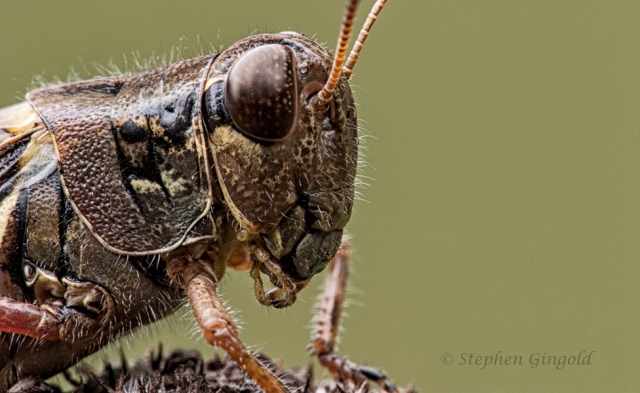As far as I can tell, these Red-legged Grasshoppers (Melanoplus femurrubruml are our most ubiquitous orthopteran in my locale. I rarely see another but I am not beating the bushes looking for them either. How the red-legged grasshopper got his name is fairly obvious, I think.
 I’ve been going out into the yard lately just hand-holding my old 40D with the 100 macro and a flash to balance the strong light of the afternoon…something different for me. I am very unsteady with my hands, but the 1/200th second exposure with the flash is helpful in that regard. This image is a fairly tight crop but holds up well enough for the web.
I’ve been going out into the yard lately just hand-holding my old 40D with the 100 macro and a flash to balance the strong light of the afternoon…something different for me. I am very unsteady with my hands, but the 1/200th second exposure with the flash is helpful in that regard. This image is a fairly tight crop but holds up well enough for the web.
Eight or so years ago, I tried a portrait of another red-legged that was sitting on top of a spent bee balm head. The 10D had this 100 mounted with two extension tubes on the back and two closeup filters mounted on the front. I was amazed that it worked.
 It’s not as crisp as my current efforts, but probably the closest in your face shot of a grasshopper I will do.
It’s not as crisp as my current efforts, but probably the closest in your face shot of a grasshopper I will do.

The complexity of these little creatures is something to behold. I’ve never been particularly fond of grasshoppers, and was afraid of them as a child. Eventually, I figured out all of that whirring and buzzing was part of their attempt to get away from me, and things between us improved.
This is a handsome one, with those red legs. He’s clearly giving you the once-over.
LikeLiked by 1 person
That complexity of structure is part of what attracts me to them. That and the amazing variety of species…thousands upon thousands of identified individual species and who knows how many more yet undiscovered.
He actually was checking me out, Linda. As I moved so did he…but I don’t think it was admiration…most likely survival.
LikeLike
Grasshoppers are so armored looking, they fascinate me. Some years ago (ok, many) I met a college professor who wanted a home for some large southern grasshoppers he’d had in his classroom, so I took them home for my son. He carried them around and treated them pretty much the way he’d treat a cat. They thrived on the attention and lasted through a couple of molts. We even made his Grandparents watch them one weekend! Ha! I should mention that to her again one of these days…farmers don’t look kindly on grasshoppers and here they were grasshopper-sitting!
LikeLiked by 1 person
Yeah, I imagine handing a farmer a box full of grasshoppers would not bring a smile.
It does look like this one just donned a piece of neck armor, doesn’t it. 🙂
LikeLiked by 1 person
Gorgeous shot, the detail is quite amazing; I love the expression you captured.
LikeLiked by 1 person
It is definitely making sure of what I am doing. Thanks, Charlie.
LikeLike
Excellent close-up. Grasshoppers are pretty to me, unlike some of the other insects. But gee can they do serious damage. Some years they have been know to eat the bark of trees, siding of houses and, kill many plants. If too much foliage and bark is eaten then the plant, shrub or, tree dies. That happened at my old farm house in the country (( sold the house and kept the land) but rose bushes were killed that year.
There is a product called Nolo- I think that is the name, that inhibits reproduction of the grasshopper but is not an actual poison. It must be spread around early in the season before the “hopper” gets a foot hold.
LikeLiked by 1 person
Insects can surely wreak havoc on crops and other plants for sure. But we are always the interlopers. They were here and occupying their niches long before we bought a piece of land or tilled a field. So there needs to be a balance with humans and nature. I don’t see that happening since so many believe we should be fruitful and multiply at the expense of all else.
LikeLiked by 1 person
Very true, Steve.
LikeLiked by 1 person
I’m also impressed that you succeeded with a 100mm macro lens mounted with two extension tubes on the back and two closeup filters mounted on the front. Without those optical aids we wouldn’t be able to see all the tiny hairs on the grasshopper.
A question: why hand-hold your old 40D when you could be using your current camera? Is it because of the 40D’s 1.6X crop factor?
LikeLike
I think it was just a bit of dumb luck, Steve. I have tried similar combination since and the results have been less successful than this image. The more stuff we put between ourselves and our subjects the greater chance for quality loss. I’d be much better off with an MP-E65.
I’ve been hand-holding for a few reasons. First is because I’ve been photographing during sunlight on my subjects and the heat has them too active for chasing with a tripod. So even if I sit and wait for one to land on a flower they are too busy gathering pollen at a frenetic pace to achieve much success. And I will not cool my subjects to slow them down which many photographers do. Second is to try to get better at it…an exercise.
LikeLike
And…I only do it with the insects. The tripod still rules for all else.
LikeLike
I know what you mean about insects active in the heat. Yesterday I was trying to photography a tiny native bee moving rapidly about on a small flower head, and even with the shutter set at 1/000 of a second I manage only three acceptable pictures out of a couple of dozen attempts.
LikeLiked by 1 person
I think the heat’s gotten to my brain, too. I was trying to photograph a bee at 1/1000 of a second and managed only three decent pictures.
LikeLiked by 1 person